Feel the great landowner culture and port town Niigata-Japan’s number one rice and sake production area fostered in a large granary
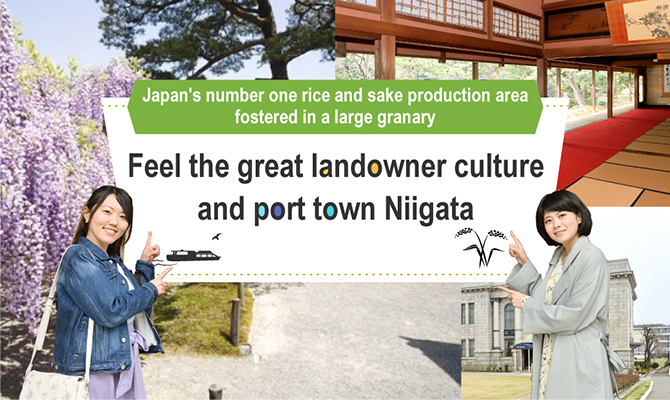
What is the great landowner & port town cultures?
Situated on the vast Niigata Plain, Niigata had long been the largest rice producing area in Japan. When the system for the payment of taxes changed from rice to money in the Meiji Period (1868-1912), farmers who could not deal with money sold their land to other owners, creating great landowners with over 1,000 ha of properties.
Sea transportation to deliver rice resulted in the development of a flourishing Niigata Port and attracted many people to the area, which in turn, fostered Japanese-style restaurants and geisha culture to entertain business clients.
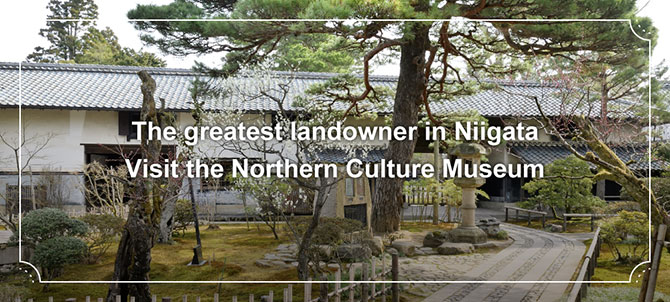
Ito family mansion shows the life of a great landowner
Located in the suburb of Niigata City, the Northern Culture Museum is the mansion of the Ito family, the greatest landowner in Niigata. The construction started in 1882 and took eight years to complete. The 4,000 square meters home with 65 rooms was constructed on the 30,000 square meters land. The living room, tea-room, and garden are open to public as valuable remnants that show the life of a great landowner. It is a rare museum in that the Ito family still occupies the mansion.
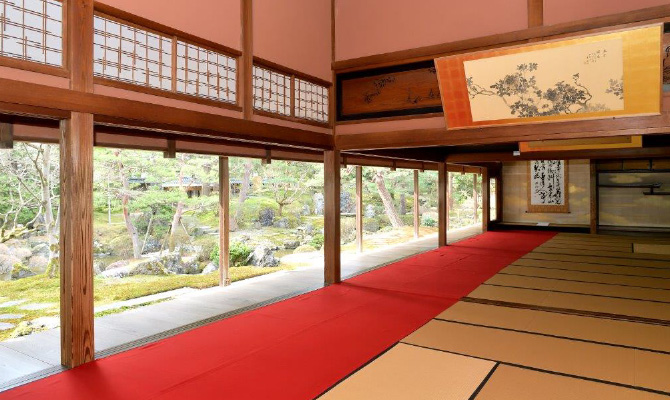
Growing into the greatest landowner in Niigata during the Meiji Period
The Ito family began farming in the mid-Edo Period and succeeded in business to become a wealthy family. From the Meiji Period, the family began purchasing farmland and became an owner with 14 million square meters of land at its peak. There were nine landowner families with over 1,000 ha of properties in Japan. Five of these families resided in Niigata, and one was the Ito family.
The land reform executed after the end of WWII led to the family losing the vast land.
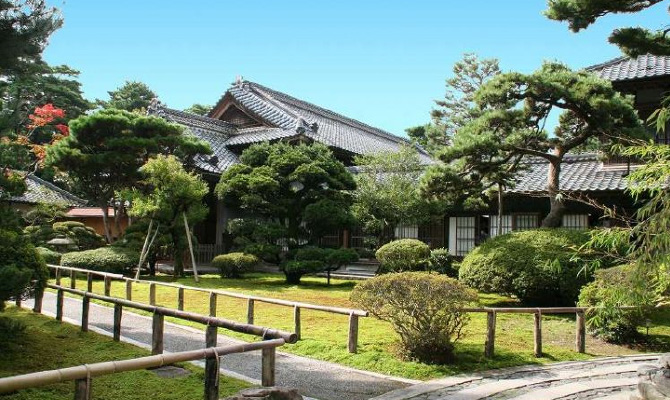
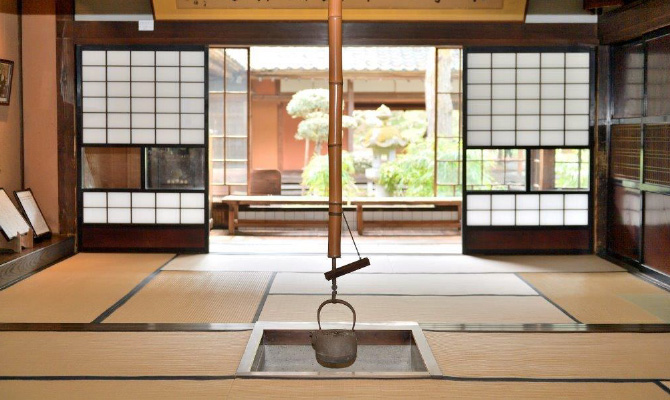
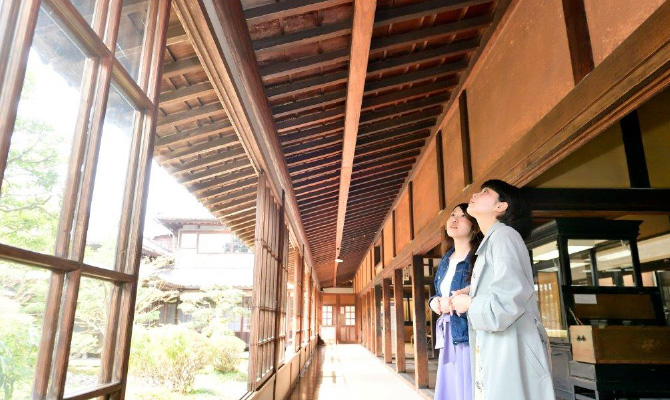
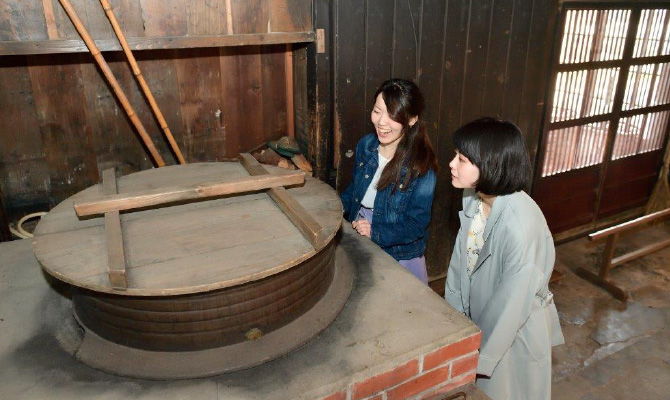
Museum born from a bond with an American
After the end of the war, Lieutenant Ralph Wright visited the Ito mansion to conduct a survey. It turned out that the 7th generation head of the Ito family, Bunkichi, and Lieutenant Wright both studied at University of Pennsylvania and they became good friends. Lt. Wright was impressed with the cultural value of the Ito mansion and appealed to GHQ for the establishment of a museum that Bunkichi had envisioned. This led to the Ito mansion becoming the first private museum after WWII.
Miraculous reunion described as “finding a contact lens lost in the ocean”
Thereafter, the 8th generation Bunkichi Ito, who inherited the volition of the 7th generation Bunkichi, looked for Mr. Wright for more than 30 years and a reunion took place 40 years after the last meeting. It was a miraculous reunion described in an American newspaper as “it’s like finding a contact lens lost in the ocean.” There are many exhibited items that show the ties between Japan and the U.S.
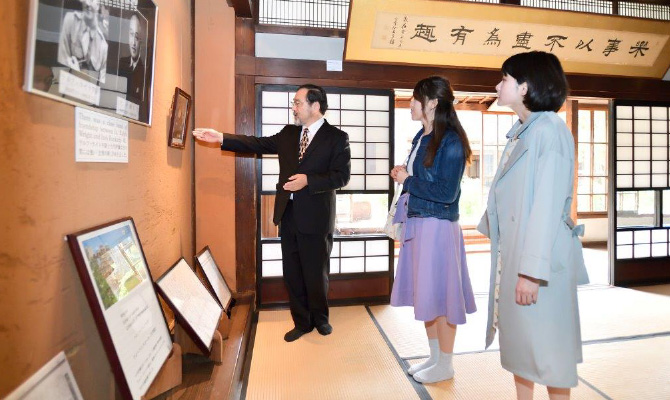
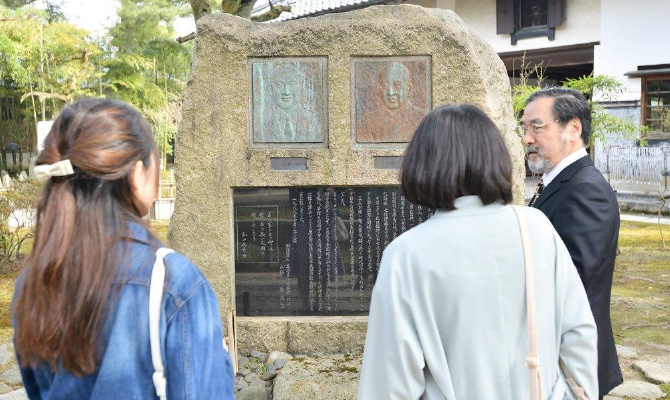
Huge wisteria in spring and tinted leaves in autumn are a must-see
The 150-year old huge wisteria tree that comes into full bloom in the beginning of May is a famous spring scene at the Northern Culture Museum.
Enjoy the scenes of nature in four seasons; the cherry blossoms in spring, the ancient lotus in early summer, the tinted leaves in autumn, and the snow scape in winter.
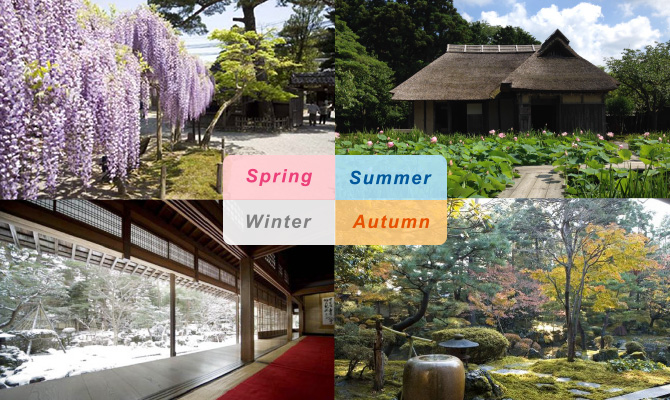
Experience culture in the Northern Culture Museum
Koshihikari Rice Cooking Experience (Using Hagama)
In the huge dirt floor dining area called Misogura, visitors can experience cooking Niigata grown Koshihikari rice with a Hagama. Hagama is a traditional Japanese cooking pot for rice.
Hagama is set on a stove, fire is lit, and heat is adjusted as advised by staff. Enjoy the sound and aroma of rice cooking while you wait. Then, taste the delicious just-cooked Koshihikari rice.
Hagama Rice Cooking Experience
- Time required
About 30 minutes - Fee
2,386 yen (includes entry to the Museum) - Minimum participants
2 (Make reservations by before noon two days prior to the desired date.) - Reservations and inquiries
025-385-2001 (Northern Culture Museum) - Facility information
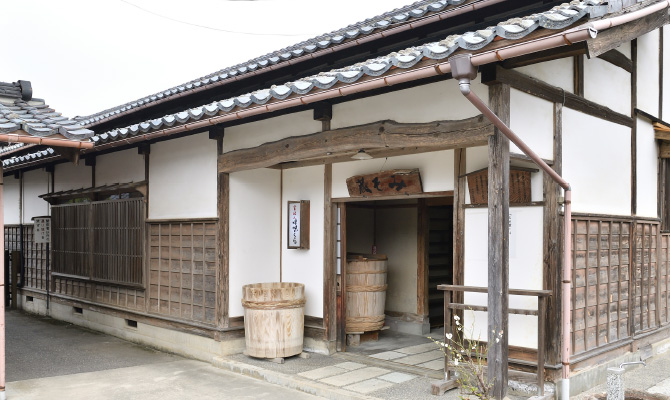
Food break Misogura
Dirt floor where over a dozen of huge miso barrels stood in the past has now been remodeled into the restaurant Misogura. Combined with an annex, Misogura seats approximately 240 people.
Niigata Shikki (Gold-Inlaid Lacquer Ware) Manufacturing Experience
Experience one form of traditional craft, Niigata Shikki, which began about 400 years ago in the Edo Period. It is easy to make your own Niigata Shikki with help from craftsmen.
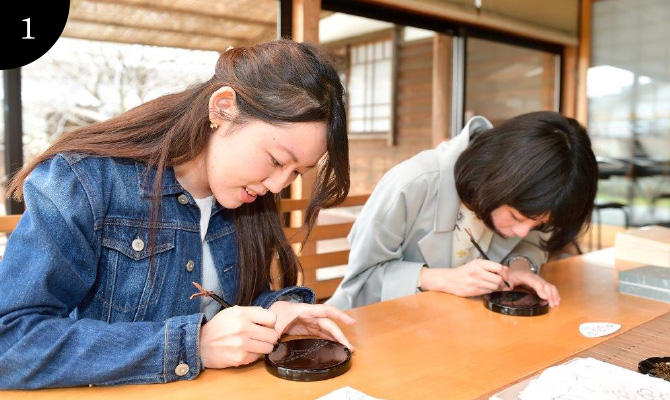
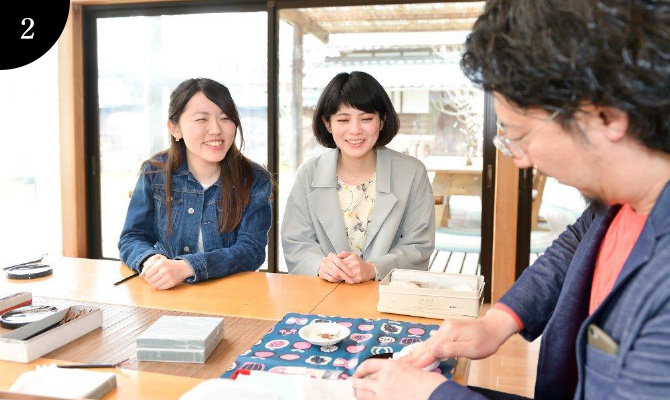
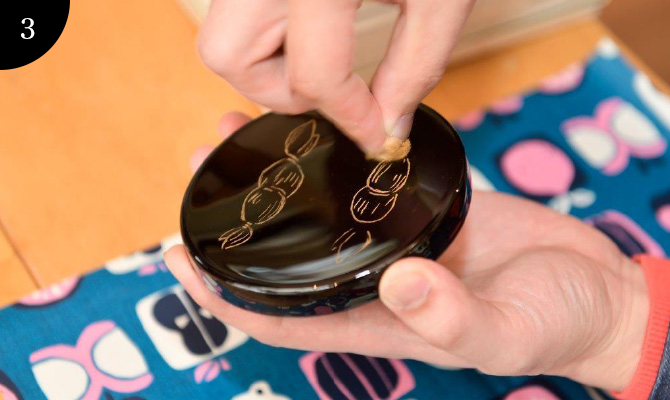
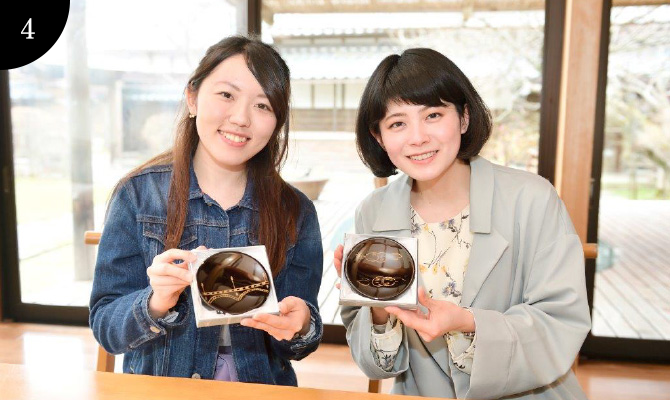
Niigata Shikki (Gold-Inlaid Lacquer Ware) Manufacturing Experience
- Time required
About 45 minutes - Fee
3,000 yen (Museum entrance not included) - Minimum participants
10 (*Reservation required) - Reservations and Inquiries
025-385-2001 (Northern Culture Museum)
Northern Culture Museum information
- Location
2-15-25 Soumi, Konan-ku, Niigata City - Phone
025-385-2001 - Open hours
Open all year round: April−November 9 am to 5 pm; December−March 9 am to 4:30 pm - Parking
Space for 400 passenger cars, 30 busses (free parking); Two location on the front and west entrances; Busses should use the west entrance parking. - Access
<Expressway> Approximately 5 minutes and 4 km from Niitsu IC, Ban-etsu Expressway
<Taxi> Approximately 10 minutes from JR Niitsu Station, approximately 20 minutes from JR Niigata Station
<Bus> Take the bus bound for Akiha-ku Office via Soumi from Bandai City Bus Center and get off at Kami Soumi Hakubutsukan-mae, 2-minute walk to the museum.
About the bus
The bus follows a scenic route along the banks of the Aganogawa River. Service is infrequent. Check the service schedule in advance.
Route bus related information
Bura-Bus by Niigata Kotsu: https://bura-bus.jp/course/senior/75
Niigata Kotsu website: http://www.niigata-kotsu.co.jp/
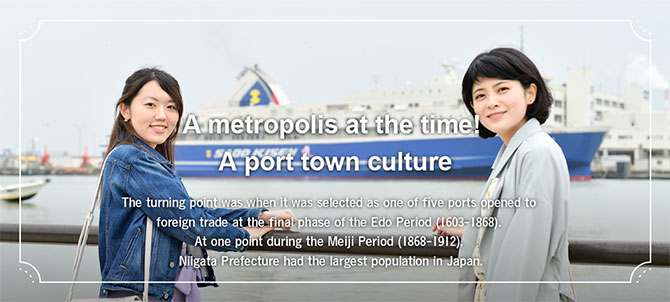
Niigata Port has been a logistics center since the Edo Period, and the town always bustled with people. It was selected as one of the five ports opened to foreign trade at the final phase of the period. When the port opened in the Meiji Period, the area developed into a center of politics and economy. There are many Japanese restaurants in Furumachi of Niigata that entertained visitors from throughout Japan, and Furumachi Geishas performing Japanese dance at banquets became popular. Niigata’s port town hospitality still exists today.
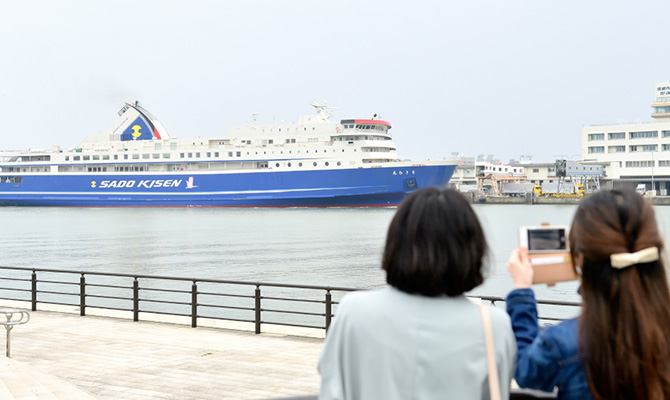
Feel the atmosphere of port town Niigata at Minatopia (Niigata City History Museum)
At the end of the Edo period (the mid-19th century), Hakodate, Niigata, Yokohama, Kobe, and Nagasaki were opened as Japan’s trading ports. The former Niigata Customs House is the only surviving custom building of the day among those built in the five ports. This building had been used as a custom house until 1966.
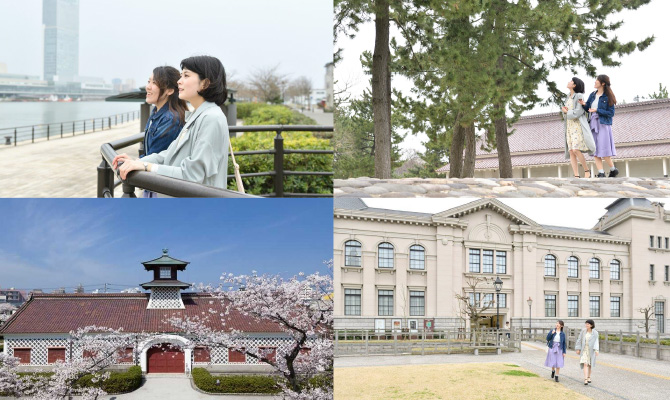
Minatopia facility information
- Location
2-10 Yanagishimacho, chuo-ku, Niigata City - Phone
025-225-6111 - Open hours
Main Building: April−September 9:30 am to 6 pm; October−March 9:30 am to 5 pm
Former Daishi Bank Sumiyoshi-cho Branch: April−September 9:30 am to 6 pm; October−March 9:30 am to 5 pm - Closed
Monday (the following day if the Monday falls on a holiday)
Day after public holidays (Tuesday if it falls on Saturday or Sunday)
Year-end and New Year Holidays (December 28−January 3), Facility fumigation period, etc. - Access: Niigata City Loop Bus
Take the <Toki Messe Sakimawari> line from the Niigata Station Bandai Exit Bus Terminal, and get off at Rekishi Hakubutsukan-mae stop (approximately 27 minutes).
> Niigata City Loop Bus (Japanese Language Only)
Shinanogawa Water Shuttle
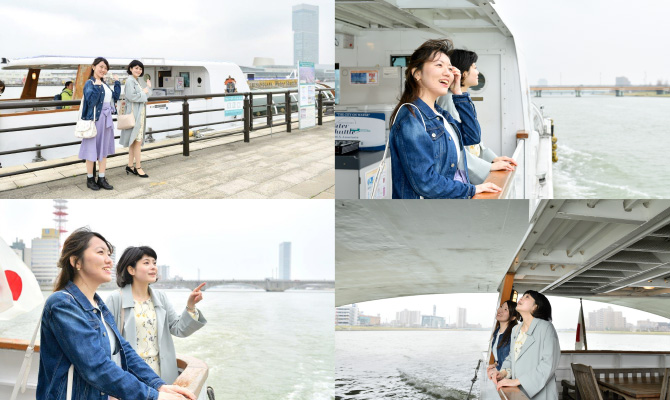
This water shuttle service between Minatopia located at the river mouth of the Shinanogawa River and Niigata Furusato Village at the upper reach. The shuttle passes under the Bandai Bridge, a national important cultural property. Enjoy the bank landscape that changes with the four seasons from the shuttle.

Shinanogawa Water Shuttle
- Shuttle service
Minatopia − Toki Messe − Bandai Bridge Nishizume (Western edge) − Bandai City − Prefectural Office − Niigata Furusato Village
Fee: 300 yen−for adults (depending on riding length / Only excursion service available in winter) - Excursion service
Required time: 25 minutes (Depart from Toki Messe)
1,000 yen for adults, 500 yen for children (Only service available in winter) - * Available for charter service by the hour
* Check the website for a detailed service schedule.
URL:http://www.watershuttle.co.jp/ (Japanese Language Only)
Inquiries: Shinanogawa Water Shuttle Co., Ltd.
Phone : 025-227-5200






